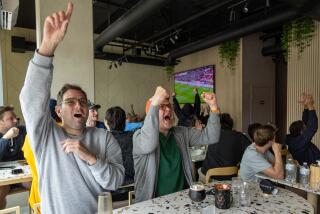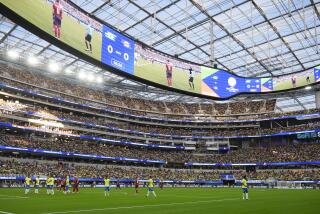WORLD CUP USA 1994 : They Caught the Fever : World Cup ’94 Will Shatter Attendance Records--Even With Dallas
DALLAS — Those Europeans and South Americans were right after all--Americans still don’t get it.
How else to explain that 54,456 turned up at Foxboro Stadium in Massachusetts one June evening to witness South Korea play Bolivia to a 0-0 tie in the first round of the World Cup?
“That would have never happened in Brazil,” observed a Sao Paulo reporter. “Everyone would have known better than to come out for that one.”
Yet, come they have, pushing attendance figures beyond soccer’s stratosphere. After 44 games through the second round, World Cup organizers sold 2,955,108 tickets, an average of 67,162 per match. And the final eight matches were sold out by early last week.
Already, World Cup ’94 has seen record-breaking crowds in the one country that has been most resistant to soccer. Organizers have sold 97.7% of listed capacity.
“A lot of people doubted we could fill the stadiums,” said Alan Rothenberg, chairman of World Cup USA. “There was fear that this would be the sterile, passionless World Cup except for a few aficionados. Instead it has been an international coming together.”
Bolstered by the U.S. national team’s success, almost a half million watched five matches at the Rose Bowl, which will play host to a semifinal, the third-place game and the July 17 final. By then, about three-quarters of a million will have attended games in Pasadena.
Other cities have done equally well. Chicago virtually sold out its first games, then fell a few thousand short in the Germany-Belgium second-round game. East Rutherford, N.J.; Pontiac, Mich.; Orlando, Fla.; Foxboro, Palo Alto and Washington had similar experiences.
In 1950, Brazil became the first World Cup host country to surpass a million in attendance. Brazilians averaged 47,432 per match. The final was held in Maracana Stadium in Rio de Janeiro before the largest single-game crowd, 199,854.
It would take four more World Cups--in England in 1966--to reach the million milestone again. The two-million mark was not passed until 1982 in Spain. And before this tournament, Italia ’90 held the attendance record of 2,515,168, an average of 48,369 per match.
Now, 44 years after Brazil’s success comes an unfathomable leap: The three-million barrier has fallen in America.
When the United States played Romania on June 26, 93,869 came to the Rose Bowl, the ’94 Cup’s largest single-game crowd thus far. Five days earlier, the smallest crowd was recorded when 44,132 watched Nigeria rout Bulgaria, 3-0, at the Cotton Bowl in Dallas.
Downtrodden Dallas has had the toughest sell of the nine World Cup sites.
“Four of the eight quarterfinalists played in Dallas, but not in major matches,” lamented William Stroube, chief of operations, who said the event has had a tremendous economic impact on the city.
The financial gains have yet to be determined, but much was made of Dallas’ inability to sell out before the tournament began June 17. And during the first week of the tournament, Dallas hoteliers complained about no one showing up for the blocks of rooms they reserved for prospective fans.
Dallas was snake bit for several reasons. In Texas, American football is an institution, and the two-time Super Bowl champion Dallas Cowboys are at the height of popularity.
Also, Texans might be a bit stubborn.
“Truthfully, a lot of people don’t know the rules (of soccer),” said Carol Padgett, the Cowboys ticket manager. “I have watched it on TV and have absolutely no idea what’s going on.”
In Arlington, baseball’s Texas Rangers opened a new ballpark that has been the summer highlight. Furthermore, the Rangers have been in first place in the weak American League West during much of the World Cup. That combination is too powerful and the Rangers are averaging 12,689 more fans per game than last season.
And then, Bulgaria and South Korea were based in the Dallas area. Teams without a large ethnic following in Texas, neither country brought the number of fans that Brazil, Belgium, Germany, Ireland and the Netherlands did.
Still, Dallas could have sold out the Cotton Bowl for all six of its games, said Jorge Herrera, a vice president with the city’s Visitors and Convention Bureau.
Herrera, a marketing specialist, said city officials were not allowed to promote Dallas because of restrictions by FIFA.
FIFA controlled the distribution of tickets through package deals with certain hotels, as well as how the World Cup could be marketed, he said.
“They sold tickets a certain way so we couldn’t help,” said Herrera, a soccer fan. “FIFA told us last year that tickets were not available, and later they were. They did not level with us.”
Joseph (Sepp) Blatter, general secretary of FIFA, dismissed the charges. He said with the exception of 15% of the tickets, distribution was handled by local organizing committees. FIFA also returned any unsold seats so the local venues could sell them.
“We have nothing to do with the ticket sales in the U.S.,” he said.
At least he didn’t try to grab any of the credit.
Through the Years
A look at how World Cup ’94 has shattered attendance records:
Host Country Year Attendance Average Uruguay 1930 434,500 24,139 Italy 1934 358,000 21,059 France 1938 376,000 20,889 Brazil 1950 1,043,500 47,432 Switzerland 1954 871,500 33,519 Sweden 1958 919,580 26,274 Chile 1962 899,074 28,096 England 1966 1,635,000 51,094 Mexico 1970 1,603,975 50,124 West Germany 1974 1,768,152 46,530 Argentina 1978 1,546,151 40,688 Spain 1982 2,109,723 40,572 Mexico 1986 2,390,331 46,026 Italy 1990 2,515,168 48,369 United States* 1994 2,952,023 67,091
* Through round of 16






